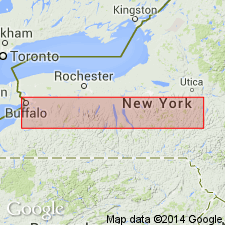
- Usage in publication:
-
- Kashong member
- Modifications:
-
- Named
- Biostratigraphic dating
- Dominant lithology:
-
- Shale
- AAPG geologic province:
-
- Appalachian basin
Summary:
Named as a member of Moscow formation [elsewhere in report, used as Moscow shale]. Named for Kashong Creek, Yates Co., central NY. Type section is on Kashong Creek, Seneca Lake. Well exposed on White Creek, East Bethany; Bowen Brook, northwest of Alexander; and in Menteth Point Gully, Canandaigua Lake. Consists of soft shale; a 3- to 5-ft-thick layer of shale containing calcareous concretions caps member, followed by 4 ft of sandy rock (also included in member). Thickness at type is 24 ft, 39 ft west of Canandaigua Lake, and 80-85 ft in Genesee Valley. Overlapped by Windom member in western part of NY; thins and disappears eastward. Characterized by TROPIDOLEPTUS CARINATUS and ADOLPHIA MARCYI. LEPTOSTROPHIA JUNIA occurs in abundance at base of hard sandy layer. May correlate with Orthonota zone of Cleland (1903) in Cayuga Lake region. Age is Middle Devonian.
Source: GNU records (USGS DDS-6; Reston GNULEX).
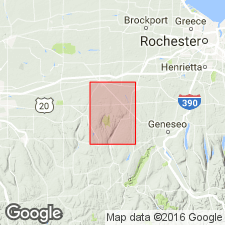
- Usage in publication:
-
- Kashong member
- Modifications:
-
- Areal extent
- AAPG geologic province:
-
- Appalachian basin
Summary:
Name proposed by Cooper for shale sequence above Portland Point member and below Windom shale member of Moscow formation. Thickness about 38 ft in Batavia quad. Here overlies Menteth limestone member and underlies Windom. Age is Middle Devonian.
Source: GNU records (USGS DDS-6; Reston GNULEX).
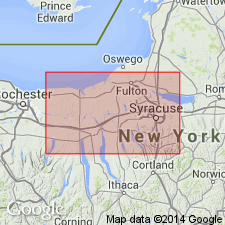
- Usage in publication:
-
- Kashong Shale Member*
- Modifications:
-
- Overview
- AAPG geologic province:
-
- Appalachian basin
Summary:
Author follows original usage of Cooper (1930), and usages by Boardman (1960), Rickard (1964, 1965), Oliver and others (1969), and Baird (1979) for Kashong Shale Member of Moscow Shale. Baird's description is the most complete. Underlain by Menteth Limestone Member and Portland Point Limestone Member of Cooper (1930), both of Moscow Shale; overlain by Windom Member of Moscow Shale. Type section is in Kashong Creek on the west side of Seneca Lake, Yates Co., where it is 24 ft thick.
Source: GNU records (USGS DDS-6; Reston GNULEX).
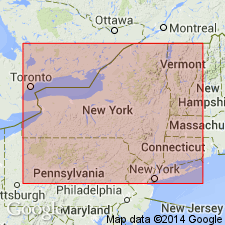
- Usage in publication:
-
- Kashong Shale Member
- Modifications:
-
- Revised
- Overview
- AAPG geologic province:
-
- Appalachian basin
Summary:
The Kashong Shale Member of the Moscow Formation underlies a newly recognized, but yet unnamed formation. A phosphate-rich concretionary shell bed at the base of the unnamed member is here designated the Barnes Gully bed. At its type locality, the Kashong is a soft, bluish gray mudstone with some thin but regionally widespread limestones and nodular concretionary horizons. Thickens to a maximum of about 25 m in the Genesee Valley and thins westward to a feather-edge in Erie Co. Resembles Deep Run in lithology, but is a softer, less calcareous, and less silty mudstone. Mudstone contains distinctive fauna including brachiopods, tabulate corals, bivalves, and trilobites. Bryozoans and crinoids are also present in the limestone beds. The Kashong can be subdivided into three shallowing upward cycles or intervals. The lowest division consists of about 0.5 to 3 m of bluish-gray mudstone with abundant small concretions in the upper part. Sharply overlies the Menteth Limestone. The lower two submembers are separated by a highly fossiliferous, shell-rich bed previously termed the RHIPIDOMELLA-CENTRONELLA (RC) bed. The middle submember consists of a thick interval of mudstones, the lowest beds being bluish-gray, sparsely fossiliferous shale. The uppermost 1 to 2 m of Kashong shale contains lenses of fossil hash especially rich in the bryozoan SULCORETEPORA. Irregularly shaped carbonate concretions are also typical of this interval. Age is Middle Devonian (Givetian).
Source: GNU records (USGS DDS-6; Reston GNULEX).
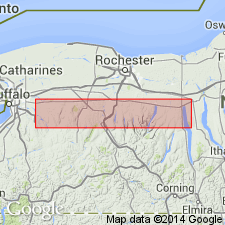
- Usage in publication:
-
- Kashong Shale Member*
- Modifications:
-
- Overview
- AAPG geologic province:
-
- Appalachian basin
Summary:
Used as Middle Devonian Kashong Shale Member of Moscow Formation in central NY.
Source: GNU records (USGS DDS-6; Reston GNULEX).
For more information, please contact Nancy Stamm, Geologic Names Committee Secretary.
Asterisk (*) indicates published by U.S. Geological Survey authors.
"No current usage" (†) implies that a name has been abandoned or has fallen into disuse. Former usage and, if known, replacement name given in parentheses ( ).
Slash (/) indicates name conflicts with nomenclatural guidelines (CSN, 1933; ACSN, 1961, 1970; NACSN, 1983, 2005, 2021). May be explained within brackets ([ ]).

